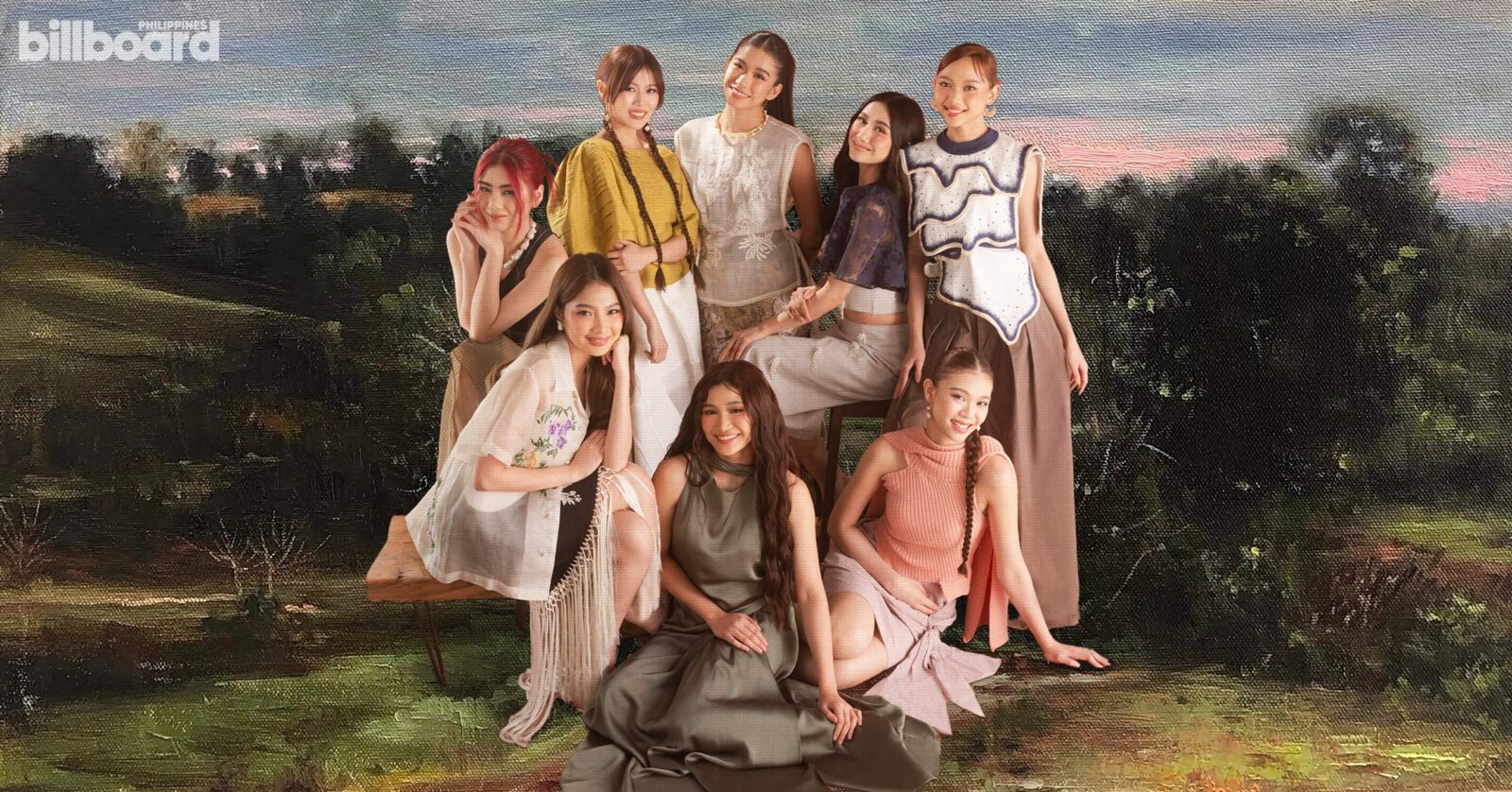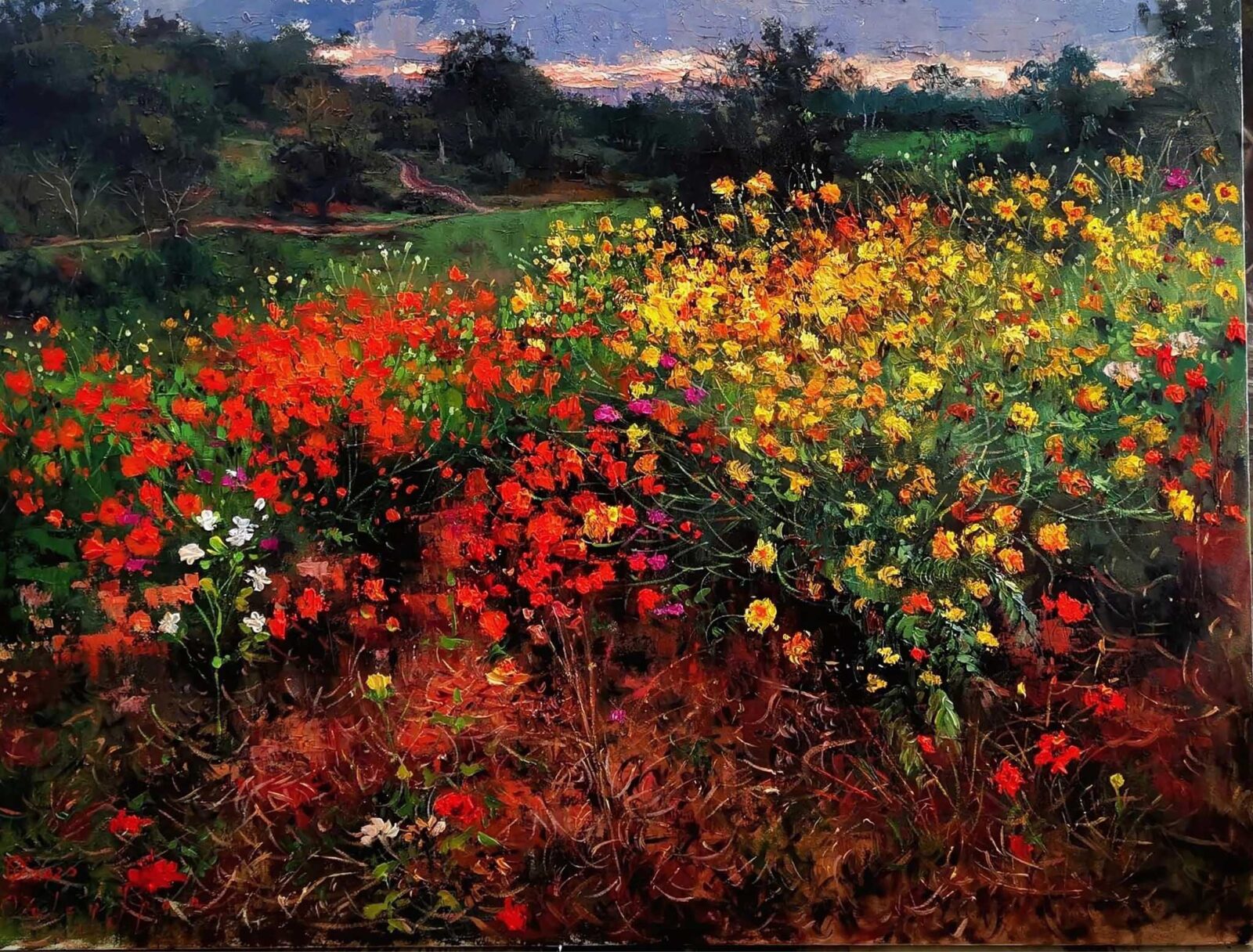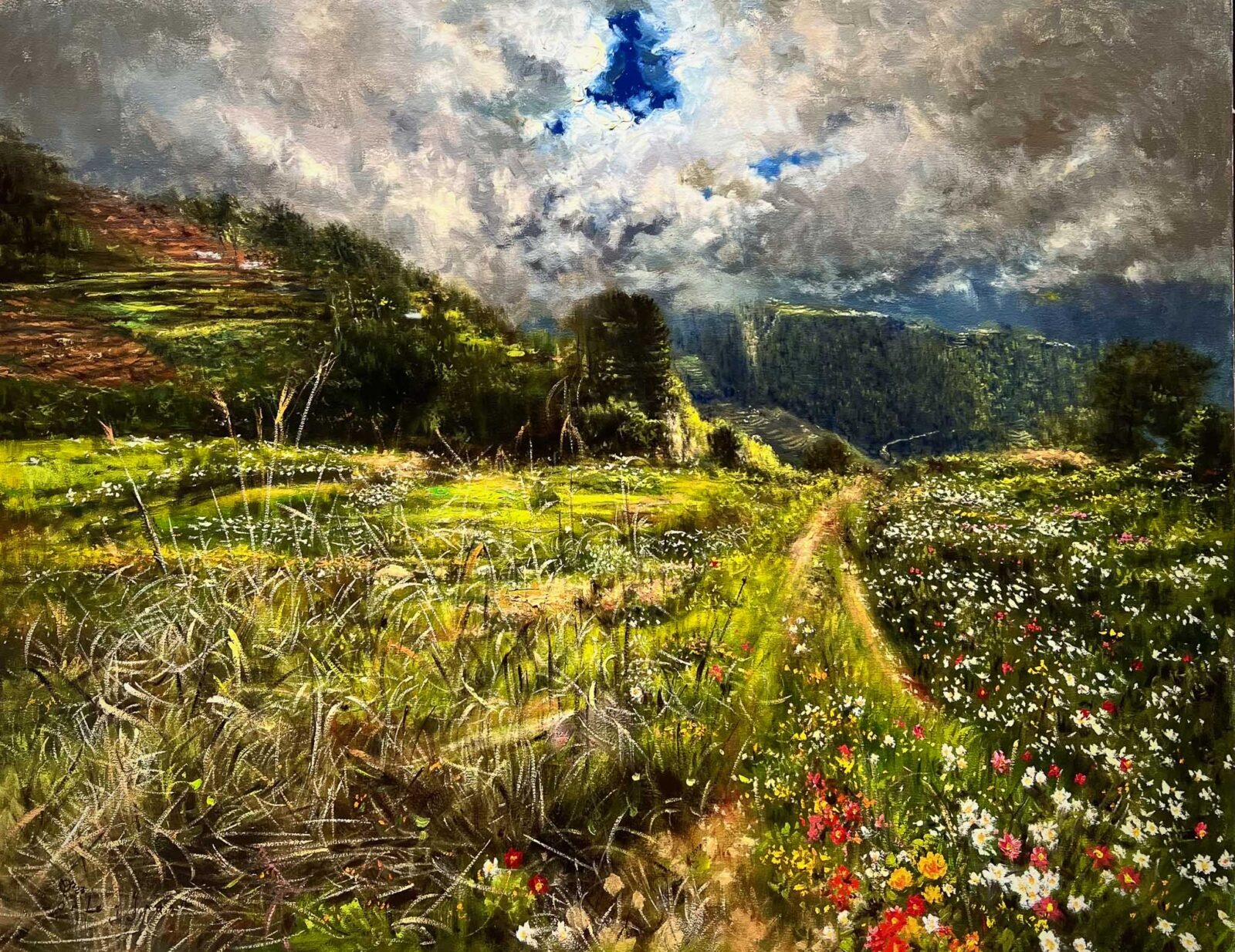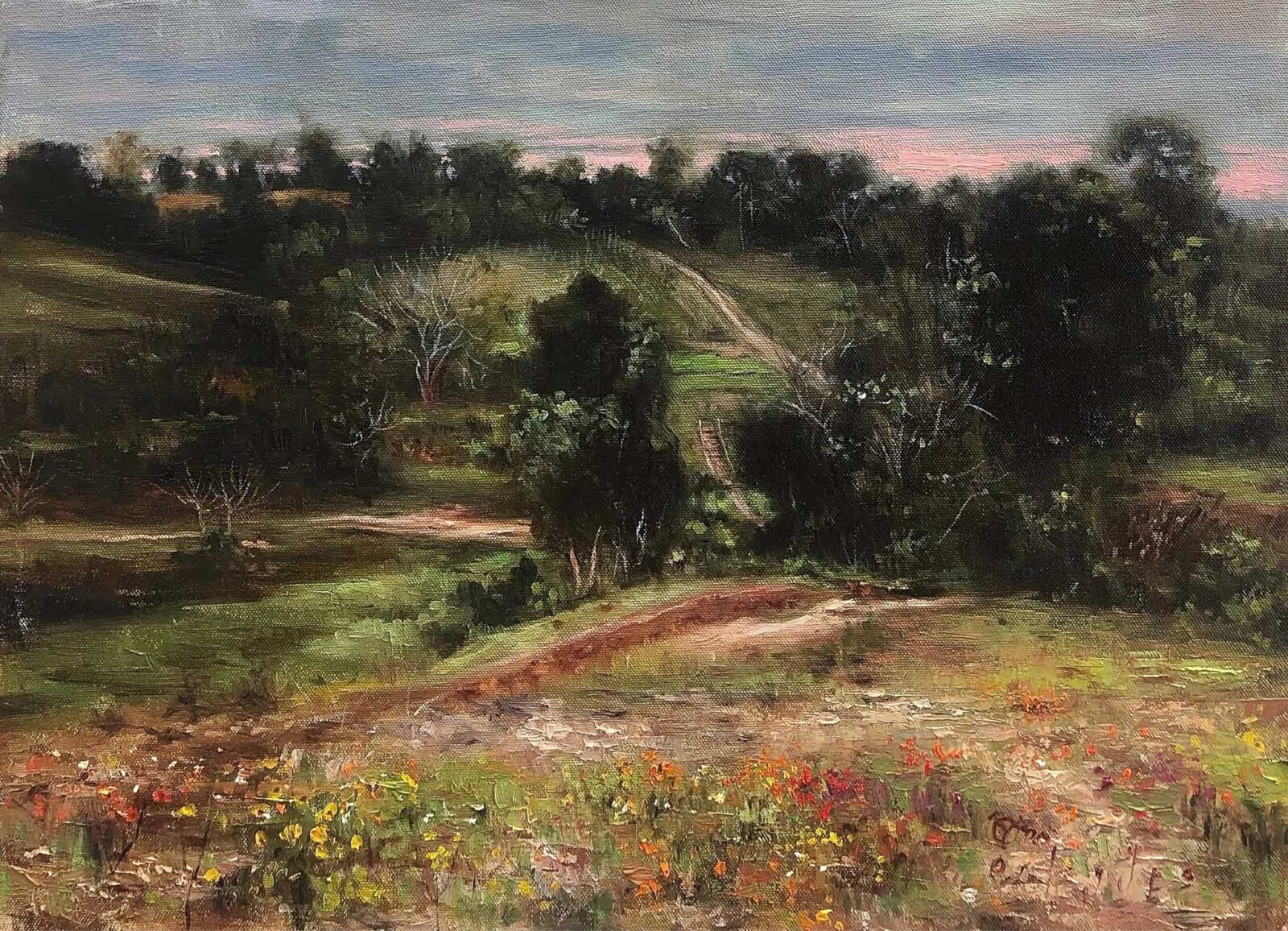Orley Ypon On Music And Creating The Paintings Behind BINI’s Cover
Where mixed-media normally translates to using different mediums to express art, Orley Ypon explains in a Billboard Philippines exclusive how he has mixed music and art for BINI’s recent digital cover feature as Billboard’s No. 1 Philippine artist.

Courtesy of Orley Ypon
Courtesy of Orley Ypon
This is where brushstrokes meet beats.
Visual and sonic arts often overlap in their respective rights — the two mesh together like bread and butter, complementing each other. Visual arts inspire music, and vice versa; and through mixed media, they find a shared home. This is perfectly exemplified in the critically acclaimed Cebu native contemporary artist Orley Ypon’s recent works, “Blooming Flowers in Pussian” and “Twilight in Pussian,” which were used for the recent digital cover feature for BINI as Billboard’s No. 1 Philippine Artist.
Orley Ypon is a 51-year-old realist painter born in the grasslands of Toledo, Cebu, who regularly brings the nature where he was brought up into his work. The award-winning artist has been a well-established name in the visual art industry ever since he bagged the First Prize in the Art Association of the Philippines’ National On-The-Spot Painting Competition in 2001 — and has been dominating the scene since. Known for his traditional realist style, “Blooming Flowers in Pussian” and “Twilight in Pussian,” are some of the artist’s first formal experiments with mixed media, and it’s been celebrated for perfectly capturing the unique but wonderfully orchestrated colors of BINI.
On that note, Billboard Philippines caught up with Ypon and delved into his life as a painter, and his exploration of mixing music and art.
Billboard Philippines: Where did you first fall in love with art? When did you first discover your passion for making art?
Orley Ypon: Nagsimula ang hilig ko sa art at a very young age. When I was around five years old, naalala ko mahilig na akong mag-drawing sa pader namin sa bahay. Thankful naman ako that my parents encouraged me instead of discouraging these creative impulses. Lumaki ako sa Toledo, Cebu, palibot ng mga bukid, farmlands, mountains, rivers, and the sea — I developed a deep connection with nature, which became my first inspiration. I would draw with kahit ano — pencil, sa mga libro ng kapatid ko, or kahit sa lupa. These early experiences gave me a sense of freedom and possibility, and it wasn’t long before I realized art was more than just a pastime — naging passion ko na siya that later would define my life.
(My love for art started at a very young age. When I was around five years old, I remember I loved drawing on the walls in our house. I’m thankful that my parents encouraged me instead of discouraging these creative impulses. I grew up in Toledo, Cebu, surrounded by fields, farmlands, mountains, rivers, and the sea — I developed a deep connection with nature, which became my first inspiration. I would draw with anything — pencil, on the books of my siblings, or even on the ground. These early experiences gave me a sense of freedom and possiblity, and it wasn’t long before I realized art was more than just a pastime — it became my passion that later would define my life.)

Courtesy of Orley Ypon
You’re a critically acclaimed and award-winning artist with an impressive body of work. Among all your creations, which piece are you most proud of, and what’s the story or journey behind it?
One of my most notable works is Interregnum, part siya ng Ahon series ko. This series explores the human struggle, symbolized by figures grappling in the mud — ahon sa kahirapan. The piece reflects the raw realities na-witness ko in my hometown, lalo na nung panahon na sa mga kabataan rampant ang substance abuse. Ginawa ko ito to reflect how people navigate challenges such as poverty and social inequality.
(One of my most notable works is Interregnum, it’s part of my Ahon series. This series explores the human struggle, symbolized by figures grappling in the mud — to emerge from the mud. The piece reflects the raw realities I witnessed in my hometown, especially at the time substance abuse was rampant. I made it to reflect how people navigate challenges such as poverty and social inequality.)
At the same time, Interregnum is a deeply personal work. Pinakita ko din ang mga struggles ko as an artist — overcoming personal and financial obstacles, finding ways to express myself authentically.
(At the same time, Interregnum is a deeply personal work. I showed my struggles as an artist — overcoming personal and financial obstacles, finding ways to express myself authentically.)
By incorporating natural and cultural elements from the Philippine landscape, I aimed to capture the universal human experience of resilience while maintaining the context of our unique Filipino identity.

Courtesy of Orley Ypon
Having trained at both the Cebu Institute of Technology and the University of the Philippines in Cebu, how did the different artistic philosophies and techniques you encountered shape your evolution as an artist?
Both institutions played a vital role sa pag-shape ng artistic perspective ko. At Cebu Institute of Technology, my training was more rooted in traditional techniques. Kinuha ko ang architecture, pero since magaling ang professor ko sa visual arts, na-retain ang alam ko sa mga fundamentals nito at kaya napunta ako sa UP to specialize in painting.
(Both institutions played a vital in shaping my artistic perspective. At Cebu Institute of Technology, my training was more rooted in traditional techniques. I studied architecture, but since my professor was great at visual arts, I retained what I learned about the fundamentals of painting and that’s why I went to UP to specialize in painting.)
The University of the Philippines, on the other hand, introduced me to contemporary approaches and challenged me to think more critically about art. So, ang (the) balance of traditional and modern philosophies allowed me to develop — grounded in realism but open to conceptual exploration — bridging two distinct but complementary artistic worlds.
Your art is deeply rooted in traditional realism, a style that originated in the West, yet your work remains distinctly Filipino in essence. How do you integrate these influences to create something uniquely yours?
I see my style as a tool for storytelling — a visual language that communicates my thoughts and emotions. While traditional realism provides the technical foundation for my work, ang soul ng art ko (the soul of my art) lies in Filipino culture, landscapes, and narratives.
By drawing from our traditions and everyday life, iba ang na-experience ko at iba ang inaral ko (my experiences and what I learned show something different). I ensure that my work remains grounded in Filipino essence while utilizing Western techniques. The blend allows me to be unique. At the same time, I aim to preserve culture and heritage in my own way.

Courtesy of Orley Ypon
Could you share the inspiration and creative process behind your artwork, Blooming Flowers in Pussian and Tiwlight in Pussian?
“Blooming Flowers in Pussian” was inspired by a collector’s property in the beautiful Cagayan Valley, where I spent several days immersed in the natural landscape. Being surrounded by the lush greenery and tranquility reminded me of my childhood in Toledo, Cebu, and the peace I found in nature. This connection deeply informed the piece. At hindi lang ito (And it’s not just a) reflection of the environment but also my experience during my time there. Mahilig talaga ako sa (I really love) nature — attracted ako sa mga bulaklak at (I’m attracted to flowers and) similar sceneries dahil sa kabataan ko pa lang (because even in my childhood), I had a relationship with it already.
Both artworks were deeply rooted in my experiences in Cagayan Valley, where I spent days immersed in the region’s ever-changing landscapes. Whether captivated by the fleeting brilliance of blossoms or the quiet transition of the sun at dusk or dawn, these sceneries became more than just visual subjects—they became nostalgic. My creative process is always shaped by moments I experience, drawing upon childhood memories closely tied to nature or personal aspirations. The intimate connection that I manifests using an interplay of light, color, and movement, reflects both the immediacy of the landscapes and the emotional resonance they held for me.
Mixed media is increasingly popular in contemporary art, contrasting with the traditional mediums you’re known for. How has your experience with experimenting in this newer medium influenced your artistic process? Have you discovered any new insights or techniques while working on this mixed-media project?
Masasabi ko na oil painter talaga ako )I can really say that I’m an oil painter). I have dabbled in mixed media in the past, incorporating garments and textiles into my work, pero not recently. Although these experiments taught me how different materials can add texture and depth, I always find myself returning to oil painting. The complexity and challenge of oils keep me inspired and focused. Dito talaga ako na-cha-challenge (This is what really challenges me).
However, I remain open to exploring other mediums in the future, particularly sculptural work. Sculpture intrigues me because it offers a new dimension, and I see it as a natural evolution of my practice should the opportunity arise. The collaboration with Billboard Philippines has opened my ideas.

Courtesy of Orley Ypon
Does music often play a role in your creative process? If so, how does it influence your work, and if not, why do you prefer to keep the two separate?
Malaking bagay ang music sa creative process ko (Music is a big part of my creative process). I see many parallels between music and painting — both involve rhythm, harmony, and composition.
When I listen to classical music, I analyze structure: the interplay—may malakas, may mahina, may mabagal, at mabilis na movements. Parang symphony — the instruments don’t all play together. May focal points, may highlights. This mirrors how I approach my work, where each brushstroke has a purpose, much like each note in a composition.
(When I listen to classical music, I analyze structure: the interplay — there are loud and soft parts, and slower and faster movements. It’s like a symphony — the instruments don’t all play together. There are focal points and highlights. This mirrors how I approach my work, where each brushstroke has a purpose, much like each note in a composition.)
Nakakapagbigay din ang music ng rhythmic guide sa creative flow ko (Music also gives me a rhythmic guide to my creative flow), helping me translate emotions into visual form. Whether it’s classical, instrumental, or even OPM and rock, the energy of music shapes the mood and atmosphere of my paintings.
What connections do you see between visual art and music? How do you envision these intersections evolving or being further explored in your work or the broader art scene in the future?
At Alitaptap, the artist-led space and residence I founded in Cavite, nakita ko (I witnessed) firsthand how music and art can come together to inspire one another. Bobby Balingit, a talented musician who shares the space with me among other artists, often brings his creative energy to the environment. Malaking bagay ang music (Music is a big part of it). Joey Ayala, whose music I greatly admire, has also visited and shared his work here. Concert and art kami minsan dito (We do concerts and art sometimes here) — multi-sensorial ang experience. Dante Silverio pumupunta dito; karaoke kami (comes here for karaoke). His passion for both music and art, presence ng mga (of the) musicians — malaking (makes a big) impact on how I view my art and outlook.
I’ve also participated in collaborative art events in the past that blend visual art and music. Madaming (There are many) opportunities for these intersections to grow, especially with new technologies and platforms enabling artists to push boundaries. Music and art combined has the ability to transcend cultural barriers.